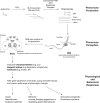Genetic basis of chemical communication in eusocial insects
- PMID: 33861721
- PMCID: PMC8015721
- DOI: 10.1101/gad.346965.120
Genetic basis of chemical communication in eusocial insects
Abstract
Social behavior is one of the most fascinating and complex behaviors in humans and animals. A fundamental process of social behavior is communication among individuals. It relies on the capability of the nervous system to sense, process, and interpret various signals (e.g., pheromones) and respond with appropriate decisions and actions. Eusocial insects, including ants, some bees, some wasps, and termites, display intriguing cooperative social behavior. Recent advances in genetic and genomic studies have revealed key genes that are involved in pheromone synthesis, chemosensory perception, and physiological and behavioral responses to varied pheromones. In this review, we highlight the genes and pathways that regulate queen pheromone-mediated social communication, discuss the evolutionary changes in genetic systems, and outline prospects of functional studies in sociobiology.
Keywords: chemosensory system; communication; genetic regulation; pheromone; signal evolution; social behavior.
© 2021 Yan and Liebig; Published by Cold Spring Harbor Laboratory Press.
Figures


Similar articles
-
The Evolution of Queen Pheromone Production and Detection in the Reproductive Division of Labor in Social Insects.Annu Rev Entomol. 2025 Jan;70(1):123-142. doi: 10.1146/annurev-ento-022124-124437. Epub 2024 Dec 19. Annu Rev Entomol. 2025. PMID: 39259976 Review.
-
Cooperation, conflict, and the evolution of queen pheromones.J Chem Ecol. 2011 Nov;37(11):1263-75. doi: 10.1007/s10886-011-0036-z. Epub 2011 Nov 15. J Chem Ecol. 2011. PMID: 22083225 Review.
-
Distributed physiology and the molecular basis of social life in eusocial insects.Horm Behav. 2020 Jun;122:104757. doi: 10.1016/j.yhbeh.2020.104757. Epub 2020 Apr 22. Horm Behav. 2020. PMID: 32305342 Review.
-
Recent Advances in Behavioral (Epi)Genetics in Eusocial Insects.Annu Rev Genet. 2018 Nov 23;52:489-510. doi: 10.1146/annurev-genet-120116-024456. Epub 2018 Sep 12. Annu Rev Genet. 2018. PMID: 30208294 Free PMC article. Review.
-
Shared genes related to aggression, rather than chemical communication, are associated with reproductive dominance in paper wasps (Polistes metricus).BMC Genomics. 2014 Jan 28;15:75. doi: 10.1186/1471-2164-15-75. BMC Genomics. 2014. PMID: 24472515 Free PMC article.
Cited by
-
Differential gene expression underlying the biosynthesis of Dufour's gland signals in Bombus impatiens.Curr Res Insect Sci. 2023 Apr 5;3:100056. doi: 10.1016/j.cris.2023.100056. eCollection 2023. Curr Res Insect Sci. 2023. PMID: 37124651 Free PMC article.
-
Microstructures at the distal tip of ant chemosensory sensilla.Sci Rep. 2022 Nov 11;12(1):19328. doi: 10.1038/s41598-022-21507-7. Sci Rep. 2022. PMID: 36369461 Free PMC article.
-
Multi-Omics Analysis Reveals TO Gene's Association With Food Selection and Lifespan in Minor-Worker Ants Post-Queen Loss.Ecol Evol. 2025 Jun 7;15(6):e71508. doi: 10.1002/ece3.71508. eCollection 2025 Jun. Ecol Evol. 2025. PMID: 40486941 Free PMC article.
-
Effects of Artificial Sugar Supplementation on the Composition and Nutritional Potency of Honey from Apis cerana.Insects. 2024 May 10;15(5):344. doi: 10.3390/insects15050344. Insects. 2024. PMID: 38786900 Free PMC article.
-
Caste- and environment-associated differential expression of olfactory receptors in pest ants.Sci Rep. 2025 Aug 24;15(1):31079. doi: 10.1038/s41598-025-16442-2. Sci Rep. 2025. PMID: 40849535 Free PMC article.
References
-
- Abbott KL, Parr CL, Lach L. 2010. Ant ecology. Oxford University Press, Oxford.
-
- Allis CD, Caparros M-L, Jenuwein T, Reinberg D. 2015. Epigenetics. Cold Spring Harbor Laboratory Press, Cold Spring Harbor, NY.
Publication types
MeSH terms
Substances
LinkOut - more resources
Full Text Sources
Other Literature Sources
